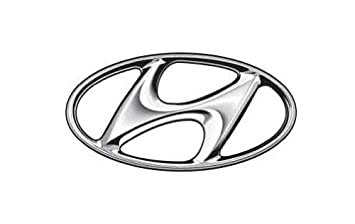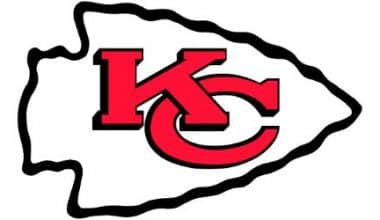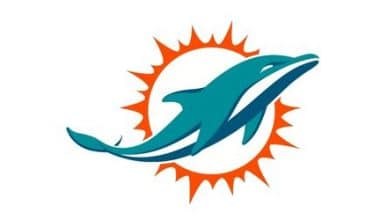The Hyundai logo we know today hasn’t always been the same from the beginning. It has changed over time and become something more universal in the eyes of people who like to drive. Sometime in 2008, Hyundai introduced the Genesis car, which had a different logo from the conventional “H” that Hyundai was known for. We’ll go over the meaning and history of these Hyundai logos and how they have evolved over time in this article.
Hyundai History: Today’s Hyundai logo
Today’s Hyundai logo is a basic and appealing design. An oval border surrounds a stylized, slanted “H.” When used in marketing materials, the Hyundai symbol is frequently accompanied by the word “Hyundai” written beneath in an angular, sans-serif font.
The Hyundai logo is as simple as it gets for many people. Like the Honda insignia, most people believe the “H” in the Hyundai symbol represents the “H” in the company’s name. While this is mostly correct, the Hyundai logo’s meaning goes a little deeper, expressing acceptance, community, and teamwork.
Hyundai Logo Evolution: A Brand Overview
Hyundai, or the Hyundai Motor Company, is South Korea’s largest automobile manufacturer. As the world’s seventh largest automaker, Hyundai debuted in South Korea on December 29, 1967.
The international automobile corporation grew quickly to become one of the world’s largest car manufacturers, producing a wide range of commercial vehicles, luxury cars, engines, and even electronic vehicles.
Hyundai is also in charge of the Ioniq, Genesis, and Kia brands.
Hyundai Logo Development: The Evolution of Hyundai Logos Over Time
Though you may remember a specific Hyundai logo better than others, the Hyundai logo design has evolved a few times throughout the years.
1969
For the first time, the old Hyundai logo appeared in 1969. An angular oval shape (akin to a vehicle window) was superimposed on a circle in this intriguing design. Over the bottom line of the strange oval form, the letters “H” and “D” appeared in a stylized typeface.
This was an interesting vehicle emblem in the 1960s, with a lot of geometric elements working together in the minimalist colors of black and white. The “H” in the emblem also had a line extending to the upper right, possibly representing a road.
The business somewhat altered its logo in 1970, altering the positioning of the inner section of the Hyundai symbol to fit completely within an oval border. This Hyundai automobile logo appeared to be closer to the vehicle badges of the period, but it was still far from what most car enthusiasts were used to.
1978
The Hyundai logo changed completely in 1978, moving away from geometric patterns and focusing on a wordmark. Due to the company’s location, the name “Hyundai” was written in Korean at this point.
The new logo was smoother than prior designs, with simple, blocky typography.
The letters “HD” remained in this sign, to the left of the monogram. The sleek lines appeared to represent the company’s professionalism and dependability, while the deep blue and white hue expressed trustworthiness.
1990
The Hyundai emblem as we know it today initially appeared in 1990. The graphic identity was altered completely, removing the “HD” as well as the corporate name. This new design seems to include a slightly slanted “H” in the same oval as the company’s prior mark from the 1970s.
The image’s hue remained white and dark blue.
According to the corporation, the “H” was chosen not only to indicate the company’s name but also to convey meaning. The H is designed to resemble two individuals shaking hands – a mark of respect.
The sleek new Hyundai logo design was slightly changed again in 2003, this time using a different shade of blue. In addition, the business put the name “Hyundai” beneath the insignia in English.
Both the wordmark and the symbol were the same shade of blue. Hyundai used a sans-serif font with a modern twist for the logotype. This is the same font used in the Hyundai emblem today.
2017
The version of the Hyundai emblem that most people are familiar with was introduced in 2017. The corporation chose a slightly different shade of blue for its wordmark this time, and the “H” symbol was upgraded to silver.
The Hyundai logo’s elements are now considerably sharper and more modern, with shading applied within the sign to give the illusion of many dimensions.
Today’s Hyundai logo retains the previous design’s visual appeal while adding a touch of sleek refinement. However, the emblem seems more like something you’d see on the back of a Hyundai automobile this time.
The lines have not been changed, and the logotype retains its characteristic, angular appearance.
Is The Hyundai Logo Two People Shaking Hands?
As previously said, it’s easy to assume the Hyundai emblem simply means “Hyundai.” It’s not uncommon for a company to use the first letter of its name in the design of its logo. This is something we’ve seen from other car manufacturers, such as Honda.
While the “H” on the Hyundai automobile badge does represent the company’s name, it is also supposed to represent a stylized image of two individuals holding hands.
According to Hyundai’s marketing staff, the two “people” connected in this logo depict a salesperson and a delighted customer shaking hands over a deal.
The letter “H” is likewise slightly tilted to the right, indicating movement and speed, as well as positive progress in the “right” direction. A slant in the opposite way may appear overly quiet and tranquil. The ellipse around the two figures appears to signify the company’s global expansion.
Colors of the Hyundai Logo
The colors of the Hyundai logo have always been simple. The logo began with a simple white and black design and progressed to several colors of deep, elegant blue.
The latest iteration of the Hyundai logo features a dark blue wordmark and a multi-dimensional silver Hyundai symbol.
Despite the fact that the sign is silver, most people would claim the main Hyundai logo color is blue because it has been connected with the corporation for a longer time. The colors silver and blue emphasize modernism, sophistication, and dependability.
What Font is used in the Hyundai Logo?
Hyundai’s logo typeface, like many of the most popular logos of all time, isn’t one you’ll find in a font library. The Hyundai font was created exclusively for the brand. At first glance, it appears to be a very plain and angular sans-serif, possibly referencing some of the geometric elements in the former Hyundai emblem.
Hyundai Motors: A Brief History
Hyundai has been at the forefront of modern automotive design and manufacturing for decades. The word “Hyundai” is aptly derived from the Korean word “hanja,” which means “modernity.” The corporation has a long history of technological innovation.
However, it has not evolved solely for the sake of evolution. Rather, the company has always had one purpose in mind: to manufacture cars of unrivaled excellence. Hyundai is now more committed than ever to providing the best driving experience possible.
We all know that Hyundai Motor Company formally launched its brand in 1967, but the automaker’s roots may be traced back to the postwar world of South Korea. It all began in 1947 when an entrepreneur named Chung Ju-Yung established the Hyundai Engineering and Construction Company. The goal was straightforward: to assist South Korea in rebuilding and industrializing following the devastation of World War II.
Unfortunately, both his expectations and his business plan were crushed by the Korean War. Following so closely on the heels of the previous big battle, Chung Ju-Yung was obliged to leave the company and seek employment with the Korean Ministry of Transportation. Although it would be more than a decade before the foundation of the Hyundai Motor Company in the late 1960s, the seeds of Ju-next Yung’s idea were planted at the nation’s transportation agency.
Evolution
Hyundai Motor Business formally began operations in 1968 with the debut of its first model, “the Cortina,” for which the company worked with Ford Motor Company. The car’s release was the first step in what would be a long and fruitful journey. The car, which was produced in the Ulsan facility in the country’s southern region, was successful enough to inspire Chung Ju-Yung in his endeavor.
Indeed, it was after the release of the Cortina that he resolved to redouble his efforts to build a strong and independent automotive company. Chung Ju-Yung brought in a number of British automotive executives and engineers to help him accomplish his aim of developing high-quality, mass-produced vehicles for the South Korean public, beginning with George Turnbull, formerly the managing director of Austin-Morris.
They collaborated and developed the Pony, which was released in 1976 and was South Korea’s first mass-produced car.
The Pony was not a one-hit wonder. The car was a truly international product, manufactured in Korea, created with the assistance of British engineers, styled by Italy’s Giorgio Giugiaro, and powered by a 1.2 liter Mitsubishi engine.
It was just a matter of time before Hyundai started selling its prized innovation on the international market. Exporting originated in Ecuador and swiftly spread to other regions of the world, including South America, Europe, and North America. In fact, by the middle of the decade, the Pony had become Canada’s best-selling vehicle. While Hyundai had yet to break into the US market, they were gaining a stellar reputation in many other countries.
The Brand’s Progress
Of course, expansion created new challenges, not the least of which was quality control. While selling cars in the new South Korean market was reasonably easy, pleasing foreign car buyers was a bit more difficult. Executives immediately realized that they needed to focus on both excellence and expansion, and thus Hyundai’s long-term strategy of quality growth was formed.
Throughout the 1980s, Hyundai expanded at a rapid pace, making significant inroads into overseas markets. However, it wasn’t until 1986 that the corporation achieved one of its most important objectives: entering the US market. Due to rigorous emissions rules, this proved challenging at first, but Hyundai soon met the challenge with flying colors.
It did so with the “Excel” model, a redesigned Pony with front-wheel drive and low emissions. South Korea’s first American product was available in two configurations: a 4-door sedan and a 5-door hatchback trim, both with a 4-cylinder engine. In the end, Hyundai’s small car proved to be a formidable competitor on the world scene.
The Pony Excel, designed once again by Giorgio Giugiaro, was created exclusively for foreign markets. It became popular with consumers (being the top-selling imported car of 1986) as well as critics (making Forbes’ list of best products) as a cost-effective alternative to numerous domestic cars. The Excel model was so popular that Hyundai kept producing it until 1994 when the sleeker Accent appeared.
Despite a promising start, Hyundai was not completely satisfied. It intended to push the edge once more in its continual drive to improve quality and raise standards, still led by founder Chung Ju-Yung. Over the next few years, the business would make significant advancements in design and technology, and by the early twenty-first century, Hyundai had established itself as one of the world’s leading automakers.
The Hyundai Brand Today
While much has changed in recent years, much has remained the same. Hyundai’s primary plant is still in Ulsan, where it created its first car, but it is now the world’s single largest integrated car manufacturing hub. A monument to the company’s development from its humble origins as South Korea’s first mass automobile manufacturer. With a 1.6 million unit annual production capacity,
But nowadays, it’s not just about quantity. Today, the company is more committed than ever to “bringing premium value into clients’ everyday life,” as CMO/EVP Wonhong Cho puts it. With models ranging from the Santa Fe to the Sonata, all of which are still available at Hyundai dealerships around the country, it has created a whole new generation of vehicles that stress remarkable design and superior technology.
Sonata, for example, is renowned not just for being the manufacturer’s flagship mid-sized sedan, but also for pioneering the brand’s new fluidic sculptural design concept. Hyundai’s creative ideology, which emphasizes natural forms and dynamic curves, has propelled the company to the forefront of automotive design.
Hyundai has grown so much over the years that it is no longer a cheap foreign option like it used to be. In the last few decades, it has continued to make not only great cars for everyday use but also a specialty and high-end cars.
The company has consistently ranked in the top tier of the World Rally Championships, demonstrating its devotion to great engineering and cutting-edge technology. Today, Hyundai is exceeding expectations once more, improving its quality, cultivating customer relationships, and entering the luxury market with an entirely new brand called Genesis.
Who Owns Hyundai?
Hyundai is owned by a Korean named Chung Ju-Yung.
Who Makes Hyundai Engines?
Hyundai and Kia manufacture the engines for their vehicles. However, there is some overlap between the two businesses. The Kappa G3LA/G3LC and Kappa G4LD engines, for example, are used in both Hyundai and Kia vehicle models.
How Did Hyundai Become Successful?
Although Hyundai has had a fantastic journey thus far, it appears that the best is yet to come. The public should expect even more surprises as the company develops into new areas, expands its vehicle line, and once again pushes the envelope of quality and inventiveness. The future looks brighter than ever for new and loyal Hyundai customers. But then, how did Hyundai achieve success over the years? Here are some lessons to learn from Hyundai’s success story:
The Chinese market
Since 2002, when Hyundai partnered with Beijing-based BAIC Motors to begin production in China, the company’s expansion has been unstoppable. They have successfully expanded into every global market worth expanding into. This kind of success is uncommon among organizations that rapidly globalize. China had already opened its borders and emancipated its market at the time of the formation of the Beijing Hyundai Motor Company on the condition that businesses from outside create alliances with Chinese enterprises. As a result, they all (Ford, VW, GM, etc.) followed Hyundai’s lead. They were all eager to enter the vast and lucrative Chinese market. The Chinese market had a cheap labor force, cheap factories, and fewer laws, so getting started was quick and cheap. At the same time, China was already booming at an alarming rate, and demand for more expensive, luxurious vehicles was increasing.
Global Expansion
Hyundai began expanding after a successful entry into the Chinese market. They strengthened their position in Europe by investing in new production facilities in Turkey, and they began selling cars in the United States and even India, where they have had remarkable success. This all appears to be so simple that anyone could do it, but believe me, it is not. Especially in the automobile sector, where brand image is critical and the market is saturated.
Changing the Image of a Brand
When they first entered other markets, including China, they rapidly learned they were seen as a lower-quality South Korean brand. They realized something had to change. First and foremost, it was false. Their autos were already of high quality, but many Korean things were not. They began to place a greater emphasis on quality and implemented the 10-10 policy. The 10-10 policy was a prominent automotive warranty that covered ten years and one hundred thousand miles. Their brand image and quality perception began to improve, which was a critical stage in their approach.
Another factor was their market adaption and distinction. When they first entered the US market, they offered two vehicles in two of the most popular vehicle classes at the time. They offered the Sonata, a large sedan, and the Santa Fe, a mid-size SUV. Both were less expensive than the usual in their class yet had a comprehensive guarantee and solid equipment/performance. People adored the Sonata and Santa Fe because they provided the best value for money.
The Secret of Strategic Management
This all appears to be quite simple, but few brands are implementing it. The secret to Hyundai’s success is a thorough examination of what a particular market needs and at what cost. Maruti was and continues to be their biggest competition in the Indian market. Hyundai, on the other hand, only provided two little automobiles that were ideal for India’s terrible and tight roads. One of the automobiles was low-priced, with a limited profit for Hyundai, but an appealing price at which people were willing to buy their first Hyundai in India rather than a Maruti. The second vehicle was the Hyundai Accent, which had a better profit margin for Hyundai but appeared less appealing to the Indian populace. Surprisingly, both models were well received by the public.
As previously stated, when they entered the US market, their strategy was radically different. It was the same for the European market. They provided more compact vehicles for Europe’s limited streets. They priced it similarly to French manufacturers’ tiny automobiles, but they provided far longer warranties.
Today
They still do the same motions now, and here’s how. They introduced their N-Performance range of sportier versions of their normal models in 2015. The I30N was their most popular model. If you study reviews and comparisons, you will notice that the I30N is a hybrid of all other hot hatchbacks, combining what people like about the VW Golf GTI and the Renault Megane RS. Once again, they did their homework and created a product that is a sure hit.
The same is true for their electric vehicles. They sell two totally electric vehicles: the “Prius-like” Ioniq and the crossover SUV Kona. They had a lot of success with the Kona in Norway, which is Europe’s electric car capital, with more than 50% of newly sold cars being electric. The electric Kona is a crossover SUV with a 300-mile range. When it was first released in Norway, it immediately received 7000 orders, and over 13,000 waiting for orders. With all of the orders coming in, their production capacities were completely overwhelmed. They understood they had to provide a reasonable electric range while still offering the most popular car design at the time, the crossover SUV.
Their differentiation strategy will not change in the future. They intend to launch a slew of new vehicles, including the flagship SUV, the 2020 Hyundai Palisade. According to press sources, their study will focus on electric automobiles and hydrogen fuel cell vehicles.
Hyundai’s Success Story
Hyundai is no longer the lowest option on the market. Most consumer evaluations and “charts” place them in the top five for quality and overall customer happiness. Hyundai is aware of this and has adjusted its strategy accordingly. While they continue to provide several affordable car models, they are no longer the low-cost South Korean automobile manufacturer. In my opinion, their prices in Western Europe are exactly the same as Volkswagen’s. I don’t mind because we’ve seen in prior years that many old and trusted manufacturers make significant blunders (VW dieselgate, for example), whereas Hyundai doesn’t.
Why Do People Choose Hyundai?
Because they are less expensive. A Hyundai or Kia has more features for the same price. Some people like the look of their automobile above the look of other cars, and Toyotas are not always superior. Hyundai and Kia have produced some excellent automobiles over the years, and some of them are still in use today.
Why Are Hyundais So Cheap?
They are mass-produced, use outdated technology, use less expensive parts, and are in short supply. Despite these flaws, they are among the highest-quality vehicles available at this price.
The History and Meaning Of The Hyundai Genesis Logo
Many people were astonished when the Hyundai Genesis Sedan debuted in 2008 without the familiar “H” badge. Instead, the distinctive emblem aided in the establishment of Genesis Motors as the luxury subsidiary of the Hyundai Motor Group. What exactly is the Hyundai Genesis logo and what does it represent? Continue reading to find out more!
Origins of The Hyundai Genesis Logo
Prior to the introduction of the famous winged Genesis logo, Genesis automobiles sold in the United States bore the “H” featured on other Hyundai vehicles. In the meantime, Genesis vehicles sold in other nations used the winged logo. When purchasing a new Genesis in the United States, buyers were given the option of the familiar “H” logo or the winged logo. As it turns out, roughly 20% preferred the winged design over the “H.”
In 2008, speculations began to circulate throughout the automotive industry regarding Hyundai establishing Genesis as a separate label. The introduction of the brand-new Genesis automobile logo fueled the conjecture. In November 2015, it was confirmed. The fact that Genesis automobiles were best-sellers and heavyweights in their niches was one of the most compelling reasons for Hyundai to introduce Genesis as a premium brand.
Meaning Of The Hyundai Genesis Logo
The two wings of the Hyundai Genesis logo are clearly identifiable. A black hexagonal shield with the word “GENESIS” is placed between the wings. The use of wings in the logo design indicates speed. Others, on the other hand, have pointed out that the wings cement Genesis as a premium brand that competes with other brands with comparable emblems, such as Aston Martin, Chrysler, and Bentley.
This winged logo can now be found on the completely new Genesis vehicle lineup, including the following:
- G70 Genesis
- G80 Genesis
- G90 Genesis
“Luxury Evolved” Genesis Vehicles
Because the Hyundai Genesis car logo is similar to the logos of other luxury automakers, it makes sense that the brand would establish itself with the slogan “Luxury Evolved.” This implies that, while the emblem may resemble those of Bentley, Aston Martin, and Chrysler, the premium vehicles bearing the Genesis logo are distinguished by a more forward-thinking approach to luxury: an approach that demonstrates that innovation, modernity, and high performance can be delivered to luxury car sho
Whether you’re looking at the Genesis G70, G80, or G90, some of the high-end standard features you can expect include:
- Headlamps with full LED illumination
- Drive Mode Intelligence
- Stop & Go Smart Cruise Control
- Multi-way power driver’s seat with power lumbar adjustment
- Stunning leather seating surfaces
- Heated front chairs
How can I report unauthorized use of the Hyundai logo?
To report unauthorized use of the Hyundai logo, gather evidence of the misuse and contact Hyundai’s legal team or a designated intellectual property protection agency for proper reporting procedures.
What is the correct size for using the Hyundai logo in print media?
The correct size for using the Hyundai logo in print media will depend on the specific application and format, but guidelines for the use of the logo can usually be obtained from Hyundai’s brand guidelines or by contacting their marketing department.
Can I download the Hyundai logo from the internet?
It’s not advisable to download logos from the internet, as they may not be official or authorized versions of the logo. The best way to obtain the Hyundai logo for official use is to request it from Hyundai’s marketing or branding department.
What is the correct format for using the Hyundai logo in digital media?
The correct format for using the Hyundai logo in digital media will depend on the specific application, but guidelines for the use of the logo can usually be obtained from Hyundai’s brand guidelines or by contacting their marketing department.
How does the Hyundai logo fit into the company’s overall branding strategy?
The Hyundai logo is a crucial element of the company’s overall branding strategy and is designed to evoke specific emotions and values associated with the Hyundai brand. The logo should be used consistently and in accordance with the brand guidelines to ensure a consistent brand image and message.
In Conclusion,
The Hyundai logo is a great example of how a simple but effective vehicle design can take the globe by storm. The Hyundai logo is also a fantastic look into how a logo may have meaning beyond what most people would instantly recognize.
Hyundai, or Hyundai Motor Company, is the name of a well-known Korean automaker that was founded in 1967 and has since grown to become one of the largest Asian vehicle manufacturers. Apart from inexpensive and premium vehicles, Hyundai manufactures engines and vehicle parts that are utilized by many other brands throughout the world.
Related Articles
- KOREAN CAR BRANDS: Best 19+ North & South Korean Car Brands in USA
- VOLKSWAGEN LOGO: Meaning, Font, History and Cars
- NEW KIA LOGO: Why Kia Changed Their Logo & Best Branding Practices
- Key Money Definition: What is Key Money? (+ Quick Guide)
- CRUCIAL BUSINESS QUESTIONS for Small & Large Businesses 2023






